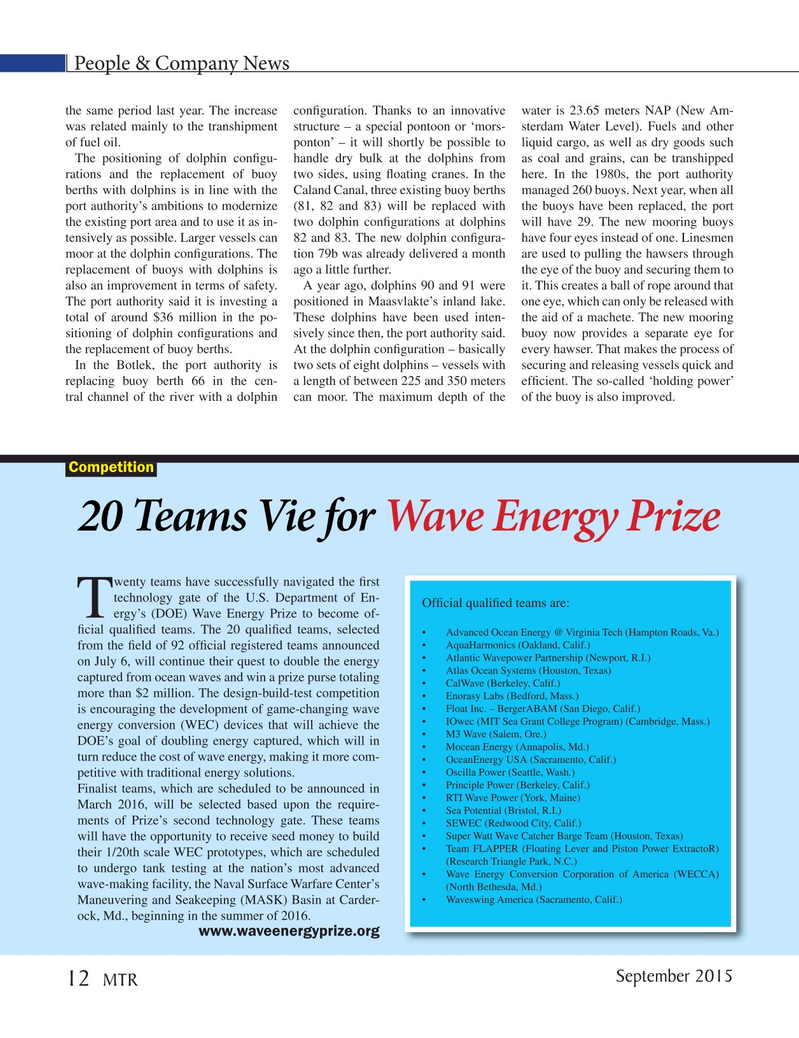
Page 12: of Marine Technology Magazine (September 2015)
Ocean Observation: Gliders, Buoys & Sub-Surface Networks
Read this page in Pdf, Flash or Html5 edition of September 2015 Marine Technology Magazine
People & Company News the same period last year. The increase con? guration. Thanks to an innovative water is 23.65 meters NAP (New Am- was related mainly to the transhipment structure – a special pontoon or ‘mors- sterdam Water Level). Fuels and other of fuel oil. ponton’ – it will shortly be possible to liquid cargo, as well as dry goods such
The positioning of dolphin con? gu- handle dry bulk at the dolphins from as coal and grains, can be transhipped rations and the replacement of buoy two sides, using ? oating cranes. In the here. In the 1980s, the port authority berths with dolphins is in line with the Caland Canal, three existing buoy berths managed 260 buoys. Next year, when all port authority’s ambitions to modernize (81, 82 and 83) will be replaced with the buoys have been replaced, the port the existing port area and to use it as in- two dolphin con? gurations at dolphins will have 29. The new mooring buoys tensively as possible. Larger vessels can 82 and 83. The new dolphin con? gura- have four eyes instead of one. Linesmen moor at the dolphin con? gurations. The tion 79b was already delivered a month are used to pulling the hawsers through replacement of buoys with dolphins is ago a little further. the eye of the buoy and securing them to also an improvement in terms of safety. A year ago, dolphins 90 and 91 were it. This creates a ball of rope around that
The port authority said it is investing a positioned in Maasvlakte’s inland lake. one eye, which can only be released with total of around $36 million in the po- These dolphins have been used inten- the aid of a machete. The new mooring sitioning of dolphin con? gurations and sively since then, the port authority said. buoy now provides a separate eye for the replacement of buoy berths. At the dolphin con? guration – basically every hawser. That makes the process of
In the Botlek, the port authority is two sets of eight dolphins – vessels with securing and releasing vessels quick and replacing buoy berth 66 in the cen- a length of between 225 and 350 meters ef? cient. The so-called ‘holding power’ tral channel of the river with a dolphin can moor. The maximum depth of the of the buoy is also improved.
Competition 20 Teams Vie for Wave Energy Prize wenty teams have successfully navigated the ? rst technology gate of the U.S. Department of En-
Of? cial quali? ed teams are:
Tergy’s (DOE) Wave Energy Prize to become of- ? cial quali? ed teams. The 20 quali? ed teams, selected • Advanced Ocean Energy @ Virginia Tech (Hampton Roads, Va.) • AquaHarmonics (Oakland, Calif.) from the ? eld of 92 of? cial registered teams announced • Atlantic Wavepower Partnership (Newport, R.I.) on July 6, will continue their quest to double the energy • Atlas Ocean Systems (Houston, Texas) captured from ocean waves and win a prize purse totaling • CalWave (Berkeley, Calif.) more than $2 million. The design-build-test competition • Enorasy Labs (Bedford, Mass.) • Float Inc. – BergerABAM (San Diego, Calif.) is encouraging the development of game-changing wave • IOwec (MIT Sea Grant College Program) (Cambridge, Mass.) energy conversion (WEC) devices that will achieve the • M3 Wave (Salem, Ore.)
DOE’s goal of doubling energy captured, which will in • Mocean Energy (Annapolis, Md.) turn reduce the cost of wave energy, making it more com- • OceanEnergy USA (Sacramento, Calif.) • Oscilla Power (Seattle, Wash.) petitive with traditional energy solutions.
• Principle Power (Berkeley, Calif.)
Finalist teams, which are scheduled to be announced in • RTI Wave Power (York, Maine)
March 2016, will be selected based upon the require- • Sea Potential (Bristol, R.I.) ments of Prize’s second technology gate. These teams • SEWEC (Redwood City, Calif.) • Super Watt Wave Catcher Barge Team (Houston, Texas) will have the opportunity to receive seed money to build • Team FLAPPER (Floating Lever and Piston Power ExtractoR) their 1/20th scale WEC prototypes, which are scheduled (Research Triangle Park, N.C.) to undergo tank testing at the nation’s most advanced • Wave Energy Conversion Corporation of America (WECCA) wave-making facility, the Naval Surface Warfare Center’s (North Bethesda, Md.) • Waveswing America (Sacramento, Calif.)
Maneuvering and Seakeeping (MASK) Basin at Carder- ock, Md., beginning in the summer of 2016. www.waveenergyprize.org
September 2015 12
MTR
MTR #7 (1-17).indd 12 MTR #7 (1-17).indd 12 9/1/2015 9:42:34 AM9/1/2015 9:42:34 AM

 11
11

 13
13
